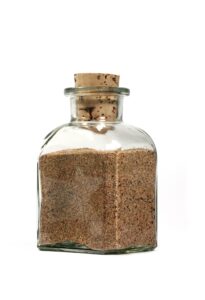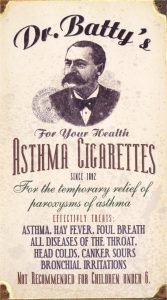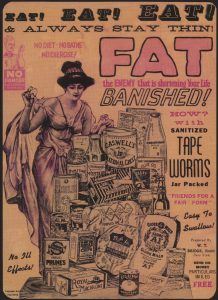Source: The Graphic (London) 13 October 1894
I haven’t tried to transcribe this for obvious reasons, but I think it should be clear enough, and you can click to make it bigger. Some of the assertions on the sleeves of those elegant arms sound better than others; ‘touches the spot for hemorrhoids’ doesn’t conjure up a particularly attractive image, but an accurate one nonetheless. For stubborn cases, suppositories were available, and one advert cheerfully announced to the world that Lord Carrick was indebted to Homocea for the cure of his piles.
Homocea and its tagline ‘touches the spot’ became a household name in the last years of the 19th century and it was certainly still around during World War II, if not later. As well as the original ointment, there was a strong form called Exaino or Homocea Fort, and a Homocea Soap. In 1897 the Soap and its related product, the Hair Wash, were highly recommended in The Nursing Record and Hospital World, which said that the soap was ‘very soothing and softening in its action, and is very fragrant and pleasant, moreover, to use.’
The BMA’s More Secret Remedies reported in 1912 that the ointment comprised a large proportion of eucalyptus oil, small amounts of lemon oil and ammonia, beeswax, lard and coconut oil. The 2s. 9d. tin contained 2 ½oz, the cost of ingredients being about 2 ½d.
Homocea Ltd certainly went in for eye-catching advertisements. The one below is from The Graphic in 1895. The lifeless body of the poor faithful little dog, who only moments ago was trotting happily along the path day-dreaming of chasing rabbits, adds a certain level of drama that we could probably have done without.
P.S. I’m scheduling this post to appear on Monday 12 Oct. I’m not actually here as I’m speaking at Chester Literature Festival, so if the post doesn’t come out right, I’ll fix it when I get home on Tuesday.





Oh, that poor little dog! It looks very familiar to me!
Oh dear, yes, it must do! I think this ad would have worked OK without any mention of the dog, but I suppose the idea was to make it stick in people’s minds.
And I also see that it is the woman cyclist who is the culprit. Hmmm.
The ad with all the hands is quite amazing-looking, too.
At least this one’s got some actual active ingredients in it, in the way of antiseptics and emollients. Not so sure about the ammonia, though.
Lidian – Hmm, yes – it does look as though it’s all supposed to be her fault!
Jess – the eucalyptus makes it sound quite nice. I should think the soap in particular would have been pretty good.
If you are looking at the advert from a feminist standpoint, Lidian and Caroline, I suspect you should be pointing out that the woman is adhering to traditional stereotypical female roles as tending to the male in a subservient manner. I think the ad is actually portraying the man as the culprit for the dog’s death, he has been injured, presumably, when falling from his (larger, damaged) bike in the collision with the dog; if anything the woman is a secondary victim as the dog’s owner.
I saw the top advert in a January 1895 edition of Punch, to find it was made of seemingly benign ingredients was disappointing; I had hoped it to be a highly addictive, pre-prohibition opiate of some sort…
Both of them seem remarkably unconcerned for the mutt’s fate – if it were the woman’s, I’d expect her to be trying to revive it rather than being sympathetic about the feckless bloke’s arm. But then again, it is probably drawn by a man, who would like to believe that he’d be more important than the dog.
We’ll just never know, I suppose 🙂 They should have done a whole series developing the drama, like those old Gold Blend ads.